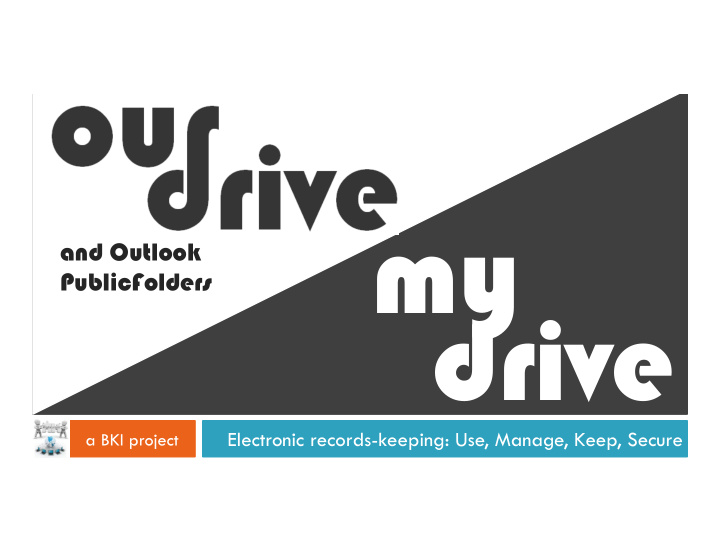



my and Outlook PublicFolders drive Electronic records-keeping: Use, Manage, Keep, Secure a BKI project
Introduction ¤ Shared drives need to be used in a manner that maximises the business benefits and minimizes the risks and costs to UNESCO. ¤ Need for an updated, simple set of business rules on the use and management of UNESCO's shared drive environment. Important: UNESCO records are the inalienable property of the Organization (AM item 9.7), and as such, no records shall be stored on servers external to UNESCO premises at this time, including cloud servers. 2
professional records space Use Manage Keep Secure Use for your OurDrive is For you and your OurDrive is central professional work backed-up and work group (i.e., records) archived Restructuring or Permissions as role changes only Structured by Your/UNESCO wide or narrow as require a change function/activity records should required to permissions not never be stored on structure Don’t use it for MyDrive or your External access via private information hard-drive UNESCO Connect 5
professional records space ¤ Assign a role for managing structure- permissions to the Office’s file system in coordination with BKI and RM. Creates folders and assign permissions. ¤ As an Office, reflect upon functions/activities performed as part of your mandate, then select the relevant functional categories from the model classification scheme. AND SECURITY ¤ Next, as an Office, decide on role-based permissions. Consider Read/Write vs. Read- EXECUTION only. More open the better. 6
professional records space ¤ Each category comes with 6 standard activities. Office decides which are relevant. ¤ Office decides what additional non-standard categories are required for activities/transactions. ¤ Do not personalize folders. AND SECURITY ¤ Paper files should mirror the same classification. EXECUTION 7
Outlook PublicFolder - professional emails space ¤ Records-keeping for email Inbox / Sent Items ¤ Outlook PublicFolder is accessible via Outlook and available externally via WebApp n not really ‘public’ ¤ Role based permissions to those areas of the Field unit PublicFolder classification tree that each role should have access to. Should be same as OurDrive. ¤ Users drag-and-drop emails 8
personal documents space Use Manage Keep Secure MyDrive is yours MyDrive is central MyDrive is MyDrive is 5GB backed-up and Only you have If you move work recoverable access to MyDrive groups, you keep Use for personal your MyDrive IT is not documents External access via responsible for UNESCO Connect recovery of data Don’t use it for stored on your records or for hard-drive private information 3
personal documents space ¤ Create a single centralized directory of folders for each person employed by Office ¤ Access only for that person during their employment ¤ Retain for separation + 2years 4
What goes where? MyDrive (personal documents) OurDrive (records) PublicFolders (email records) UNESTEAMS Collaboration, sharing, Objective internal dissemination ü Project templates ü Storage, Access, Re-use, Record-keeping Version mgmt. ü Simple workflows ü Notification/alerts ü ü Emails created or received in ü Your CV Documents created or received in the course Documents Types of documents ü Professional/career info of your work, project, etc. and which the course of your work, uploaded for ü Training, security and provide EVIDENCE of an activity, decision, project, etc. and which information development records or transaction: provide EVIDENCE of an dissemination ü ü Early drafts documents not All administrative matters activity, decision, or beyond one’s work ü used for activity/decisions All programme/project matters transaction. group ü Documents you keep and use including research, drafts and final for reference purposes only versions of documents, reports, minutes, presentations, etc. Archived No Yes. Archived centrally by e-SAFE. Yes. Archived centrally by e- Not yet. Future To be configured for your Office. SAFE. Possible now. development. 9
Managing the change ¤ But I save my documents to my computer (C:) ? Important : IT shouldn’t be responsible for the n No information created or received as part of transfer/back-up of your work should be stored on your computer . locally stored data Hard-disks can fail at any moment and they do! (whether of a professional or private Unnecessary risk to UNESCO records and nature), or the recovery unnecessary cost of recovery for IT. of said data in the case n Copy information to the appropriate drive of disk failure. according to slide 9. Important: Please be reminded that removable media (e.g., DVDs, external hard drives, USB keys) and third-party storage (e.g., Dropbox) should not be used to store information of organizational value. 10
Ensure business continuity by capturing knowledge Records Management CHECK-IN ¤ Appropriate access immediately for newly employed persons to OurDrive/MyDrive and Public Folder. ¤ Intuitive access should be set-up by IT. 11
Ensure business continuity by capturing knowledge Records Management CHECK-OUT ¤ To ensure continuity of Office work, the AO should confirm with all separating staff and non-staff that records are saved to OurDrive and Public Folder respectively. Supervisor should also confirm. ¤ Permissions should be verified to ensure remaining colleagues have required access to continue work. 12
Ensure business continuity by capturing knowledge Records Management CHECK-OUT ¤ No records should be left on MyDrive or on the hard-drive. ¤ The Exchange account should be retained (not archived) for separation + 2 years. 13
BKI Next Steps Function/activity classification § Naming convention § Benefit from electronic archiving via e-SAFE 14 §
Recommend
More recommend